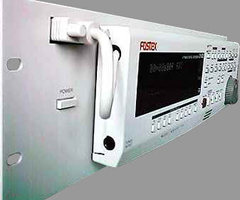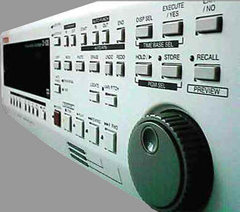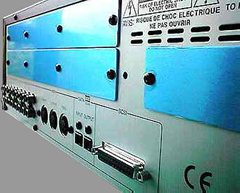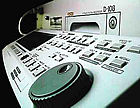| |
| INTRODUCTION |
 |
|

|
Equipped
with removable control panel and analog-style control/function keys,
the D-108 is an intuitive and extremely user-friendly recording
unit.
The control panel can be locked to the front of the module (3U)
for convenience during transport and then removed once in studio
in order to be placed in any confortable position.
The panel is connected to the corresponding port of the module thru
a quite short cable (about 10 cm.). Anyway, it's possible to find
an optional extension cable to place the panel in the desired place.
 Data
Management Data
Management
 Operating
System Update Operating
System Update
 Technical
Details Technical
Details
|
| |
| MAIN
PLUS |

|
| |
The
D-108 is a stand-alone multitrack digital recording system that
allows a 8 tracks simultaneous recording / playback at 16-bit resolution
using an internal or external Hard Disk as storage media.
It offers powerful features, usability and wide flexibility, due
to the following main technical specs:
|
|
|

|
Removable
front panel. In terms of ergonomics, this is one of the most
useful and pleasing features of the system.
The front panel can be easily removed, allowing a convenient remote
control of the unit and a consequent optimization of the space available
in the recording studio.
The panel, divided into control section, function/transport section
and display, is really user-friendly and very intuitive in terms
of operation.
The lack of a backlit LCD display doesn't compromise the Editing
and Setup functions management.
All messages and data are, in fact, clearly displayed on the high-visibility
large FSP screen.
Built-in analog and digital I/O. The D-108 is equipped with
8 built-in analog RCA In/Out connectors. Moreover, 2 digital ADAT
Optical In/Out ports are also available (8 In + 8 Out), switchable
to S/PDIF (stereo).
Normally digital ports have priority in recording/playback, but,
in S/PDIF mode digital and analog simultaneous recording can be
performed: the digital signals coming from an external device (i.e.:
CD, MD or DAT) can be recorded on 2 tracks, while 6 tracks are still
available for the incoming analog signals.
The availability of built-in analogdigital
ports is a big advantage. The basic configuration of the D-108,
in fact, allows an immediate audio recording without installing
any optional card.
Simultaneous 8 tracks recording/playback (with no data compression)
is also available.
|
| |
|

|
Furtherly,
8 balanced audio In/Out (D-Sub 25-pin connectors) can be added, installing
an optional 5040 expansion board in the relevant slot of the rear
panel.
Also, timecode facilites can be available installing an optional 8345
board (TC/SYNC) in a second slot still located on the rear panel.
This expansion board provides LTC In/Out connectors and enables the
D-108 to support slave operation for the incoming LTC and synchronization
with Video reference signals and Word clock.
LTC, converted from the internal MTC, can also be output. The user
can select from a number of Sync preset combinations.
Finally, the digital ports can also be used to save/load
the data of a Program (song) to/from DAT or ADAT. This in case a E-IDE
Hard Disk is used as a current drive. More in details:
- Memory data: Clipboard In/Out, Auto Return Start/End, Auto Punch
In/Out points
- Time Base: ABS, MTC or BAR/BEAT/CLK
- Setup mode: Time signature setting ( 4/4,3/4,etc.), Tempo setting
(i.e. 120), Click on/off setting, Preroll Time setting (from 0 to
10 sec. in 1 sec. step), MIDI Sync Out setting (CLK, MTC or off),
MTC setting (Frame rate, Offset and Offset mode), Slave mode on/off
setting, Slave type setting, Sampling frequency setting (44.1 or 48
kHz).
Mass storage. The D-108 rear panel is equipped with a built-in
SCSI-2 port that allows to connect a SCSI device (HD, MO, Zip, Jaz)
as a current drive or backup unit to save/load data.
Up to 2 SCSI units can be connected to the SCSI port. This means the
current drive and the backup SCSI equipment can be connected in chain.
|
| |
 |
The
front panel of D-108 features a slot (normally covered by the control
panel) able to receive a removable case (included in the package of
the unit) containing an optional HD E-IDE. Installing this internal
device, the system becomes extremely compact and complete, without
any loss in terms of recording time.
The last software version 1.10, in fact, allows to use E-IDE Hard
Disks with a huge recording capacity (approximately up to 30 Gb ).
Both external and internal HD can be used.
Program (song) locations are displayed on the screen with an S for
external SCSI connected unit or a P for internal E-IDE Hard Disk.
Data can also be saved/loaded in WAV format using a DOS formatted
SCSI Hard Disk. This function is very useful and innovative because
allows to edit, process and convert the sound files using any popular
PC-based editing software.
Metronome function. The D-108 is able to generate a useful
click tone available on track 8 (analog or digital). This metronome
click tone can be generated in either play or record mode according
to the tempo map.
The tempo map includes the time signature (3/4, 4/4, 5/4, etc.) and
the tempo setting in bpm (i.e. 120). It is possible to set up to 64
different time signature and tempo points in a song. |
| |
 |
Locate
function. This function allows to store 99 time data in the [LOCATE]
key just to enable an immediate recall of the desired point of the
song, independently from the time base displayed on the screen (ABS,
MTC or BAR/BEAT/CLK).
Each of the 99 Programs (songs) can have its own independent location
points.
It is also possible to assign 6 specific individual time data to each
of the 6 dedicated function keys: [CLIPBOARD IN/OUT], [AUTO PUNCH
IN/OUT] and [AUTORETURN START/END]. These location points are useful
in performing the editing operations (Copy & Paste, Move & Paste,
Punch In/Out, Erase).
Vari-pitch function. It is possible to change the pitch of
a song during playback or recording. The range of pitch variation
is +/- 6% in 0,1% steps.
Jog/Shuttle dial. This control is very useful for a fine checking
of the locate points, allowing a digital scrubbing of the audio data
without any change in pitch.
Jog/Shuttle is also very convenient to quickly select parametrs in
Setup mode or to change values in Data Edit mode.
Additional tracks. This is another useful feature the D-108
provides. Besides the 8 real tracks, 16 additional tracks (9-24) are
available for a total of 24 tracks.
Unfortunately, the additional tracks cannot be used for recording
or playback, but they are just useful to temporarily store the sound
recorded in the real tracks (1-8). In this way, tracks 1-8 are cleared
for fresh recording.
Anyway, a convenient Track Exchange function (included in the Setup
mode) allows to swap data freely and quickly between the tracks. |
| |
| OPERATION |
 |
 |
The
control panel, that can be considered as the removable "heart" of
the D-108, is the machine-operator interface that allows to perform
any operation.
It is organized in three sections:
- The Control Section allows to select the Time base (ABS,
MTC o BAR/BEAT/CLK) displayed on the screen, to check the remaining
recording time and the disk space, to recall or erase the Programs
(songs) and assign them a name and to select the Setup functions.
The [JOG/SHUTTLE] dial, located in this section, is a general purpose
control working interactively with the adjacent Function section.
- The Function Section includes the transport buttons, the
Locate keys, the [VARI-PITCH] key and the keys that give access to
the non-destructive Edit functions (Copy, Paste, Move, Erase).
The Undo and Redo keys restore the previous or edited values after
any editing procedure
- The Display Section includes the high-visibility FSP display,
that shows the signals level and the settings.
The 8 record track select keys are located under the display.
On the right side of these keys is available the [SHIFT] key that
is useful in case of MIDI slave synchronization.
The system architecture is very intuitive allowing an immediate operation. |
| |
| CONCLUSIONS |
 |
|
Considering
handling and operation, the D-108 is a real user-friendly unit.
First of all, the basic configuration of the machine provides built-in
analog/digital ports, useful for an immediate audio recording. The
only lack is that a data mass storage device is not yet installed
on-board.
Anyway, this should not be considered as a real disadvantage but as
a Fostex choice. Any user, in fact, should choose the Hard Disk recording
capacity depending on his needs.
The D-108 provides a complete MIDI environment, supporting MTC, MMC,
output of MIDI Clock and Song Position Pointer, that can be fully
programmed in the internal Tempo Map. In this way, it is possible
the synchronization with a sequencer or a drum machine without wasting
a recording track.
On the other hand, D-108 can be expanded. Installing optional boards,
Video Sync and Word Clock with LTC In/Out connectors and balanced
In/Out ports can be available, depending on the user requirements.
The 16-bit linear quantization and the A/D-D/A 20-bit conversion provides
high quality audio recording/playback.
It could have been very pleasant to work with a LCD display built
into the convenient removable panel. Anyway, the competitive quality/price
ratio of the product and the clear readibility of the FSP display
justify the Fostex choice. |
| |
|
 |



